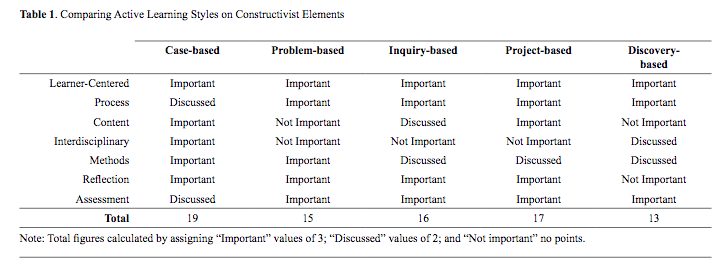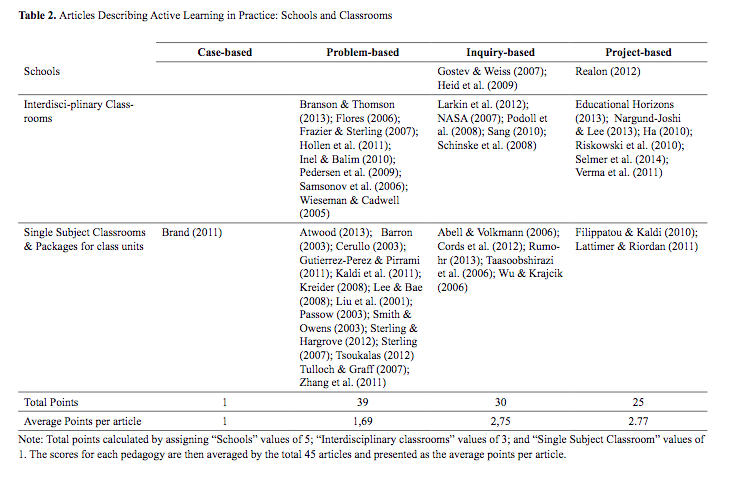Describing learning environments
re Bloom…
see Armstrong, P. (2010). Bloom’s Taxonomy. Vanderbilt University Center for Teaching. Retrieved [todaysdate] from https://cft.vanderbilt.edu/guides-sub-pages/blooms-taxonomy/
This is not relevant IMHO!!
Instead, try https://www.twinkl.com.au/teaching-wiki/5-pedagogical-approaches
Twinkl say:"There are 5 different Pedagogical approaches, being the constructivist approach, the collaborative approach, the reflective approach, the integrative approach, and, finally, the inquiry-based approach.”
See defn of pedagogy from Encyclopaedia Britannica, written by Edwin Peel (Professor of Education, University of Birmingham, England, 1950–78. Editor, Educational Review. Author of The Psychological Basis of Education): "pedagogy, the study of teaching methods, including the aims of education and the ways in which such goals may be achieved. The field relies heavily on educational psychology, which encompasses scientific theories of learning, and to some extent on the philosophy of education, which considers the aims and value of education from a philosophical perspective.”
from https://www.britannica.com/science/pedagogy
This idea about philosophy and psychology of learning are interesting attributes of an event perhaps? He also says interesting things about the disciplines and how they are different…
So working from Peel’s article, what might be some interesting attributes of education represented in the item - e.g. a photo?
- measure of place between teacher-centred and learner-centred with values 1 - 5?
- intellectual powers with values sensorimotor coordination, symbolisation (incl language and play), logical thought, power to analyse problems, appreciate formal structures (incl offering explanations)
- emotional experience from direct, immediate, uninhibited reactions to more complex, less direct, and more circumspect responses
Peel says: "The components in the child’s overall educational growth are physical and mental maturation, experience, formal teaching through language, and an urge in the learner to resolve discrepancies, anomalies, and dissonances in experience. What is required of teachers is that they enjoy and be capable of sharing with children work programs designed to modify their experience and understanding. That means making relevant experience available to the student at the right time.”
Peel has 4 subject headings: humanities, sciences, mathematics, arts. (Note Papert in Zoo proposals had engineering where Peel has maths, I think.) Peel comments on what is the same and what is different about each subject area.
The classroom for ‘group life’ has a dynamic structure … He says: "Individual pupils also conduct themselves under the influence of the groups to which they belong. Their achievements and attitudes are subject to evaluation by the group, leading to support or ostracism, and they set their standards according to those influences.”
Is age an attribute? or ability? How children (or students) are grouped can be important.
Possibley the built environment is an attribute - computer room or phones in the park?
"Theoretical, aesthetic, social, economic, political, ethical, and sometimes religious values pervade the school curriculum.”
Peel says: "Before they embark on a fresh stage of instruction, teachers must be reasonably clear about two things: (1) the capabilities, achievements, strengths and weaknesses, background, and interests of their learners; and (2) the short- and long-term objectives they hope to achieve in a lesson and series of lessons.”
but with a low-threshold high-ceiling activity this is less important because the student decides.
Peel says: "Teachers must face the problem of how to maintain curiosity and interest as the chief motivative forces behind the learning. Sustained interest leads students to set themselves realistic standards of achievement. Vital intrinsic motivation may sometimes be supplemented by extrinsic rewards and standards originating from sources other than the students themselves, such as examinations and outside incentives, but those latter are better regarded as props to support the attention of learners and to augment their interest in the subject matter.”
but we say the motivation is the student’s problem …
we do not want to get into the area of assessment….
Teaching theories (Peel)
-
Mental-discipline - In Greco-Roman antiquity, the ideal product of education was held to be a citizen trained in the disciplined study of a restricted number of subjects—grammar, logic, rhetoric, arithmetic, geometry, music and astronomy. The mode of learning was based on imitation and memorizing, and there was heavy emphasis on the intellectual authority of the teacher.
-
Naturalistic - A few educational theorists view the education of the child as an unfolding process. The child develops inevitably as a product of nature, and the main function of the teacher is to provide the optimum conditions for that development. That view leads to the theory that the child’s experience is the essential thing.
-
Apperception - Another theory assumed that human learning consisted essentially of building up associations between different ideas and experiences; the mind, in accordance with the ideas of the 17th-century English philosopher John Locke, was assumed to be at first devoid of ideas.
-
Conditioning and behaviourist - In the act of classical conditioning, the learner comes to respond to stimuli other than the one originally calling for the response (as when dogs are taught to salivate at the sound of a bell). One says in such a situation that a new stimulus is learned. In the human situation, learning to recognize the name of an object or a foreign word constitutes a simple instance of stimulus learning.
-
Cognitive - Cognitive theories are appropriate to the school situation, for they are concerned with knowing and thinking. They assume that perceiving and doing, shown in manipulation and play, precede the capacity to symbolize, which in turn prepares for comprehensive understanding.
-
Maturation and readiness - Readiness theories of learning lean heavily on the concept of maturation in stages of biological and mental development. It is assumed that a child passes through all stages of development in reaching maturity. The teacher finds out what a child is ready for and then devises appropriate materials and methods.
-
Structural - The second half of the 20th century saw a revival of the concept of the structured wholeness of experience, which Gestalt psychologists had first introduced early in the century. The whole of experience, in that view, is more than the sum of its parts. In educational terms, a new experience—such as a new historical text, an exposition in science, or a problem rider in geometry—begins by seeming relatively formless and unstructured.
See also: https://en.wikipedia.org/wiki/Pedagogy
See https://files.eric.ed.gov/fulltext/EJ1151062.pdf "Telling Active Learning Pedagogies Apart: from theory to practice" by Kelsey Hood Cattaneo 2017
"Through two distinct lenses, theoretical and practical, this article looks at five distinct active learning pedagogies: Problem-based; Discovery-based; Inquiry-based; Project-based; and Case-based learning. .... The five pedagogies are compared based on constructivist traits that are described in the literature as integral to their theory."
Note the author used both theoretical and practical descriptions and compared them....
"The descriptions of five pedagogies were classified on 6 elements which represent comparative indicators identified as being emblematic of the constructivist epistemology where active learning pedagogies belong: learner-centeredness (i.e. knowled-ge creation over knowledge provision); the focus on process and content; interdisciplinary lessons; collaborative lessons; a focus on student reflection;and the importance in intrinsically motiva-ting student work as depicted by a lack of focus on assessment."
Check: does ERIC have a taxonomy we might want to consider?
"The remainder of the section, informed by a traditional literature review, will detail and categorize five pedagogies identified by Jonassen (1991) as constructivist active pedagogies (namely, those structured around problem-based, discovery-based, inquiry-based, project-based and case-based learning), with respect to six elements of constructivism (more precisely, learner-centeredness, focus on process and content; use of interdisciplinary lessons; use of collaborative lessons; focus on student reflection; and importance of intrinsic motivation depicted as lack of emphasis on assessment)."
"Constructivist learning environments require:
- student work that is intrinsically motivating to them;
- learners reaching a certain level of self-directedness; and
- teachers who provide su-pport (scaffolding), context, relevance, and constant feedback.
In these environments learners are encouraged to build on prior knowledge, think critically, reflect, and present their information independently and in small groups. As students’ capacity increa-ses they become responsible for both the content and process of learning, which frees up the teacher to play a non-expert, facilitator, or guiding role. Grading becomes replaced by self and peer evaluation, which shifts the educational focus from an intrinsic experience to another intrinsic one and increases student’s motivation to be self-directed in the long term (Furtak, Seidel, Iverson, & Briggs, 2012; Michael, 2006; Michael & Modell, 2003 Norman and Schmidt, 1992)."
"While not meaning to oversimplify the constructivism epistemology, parsing out elements of the epistemology that may be useful in comparing the five active learning pedagogies include:
- requirements of learner-centeredness (i.e. knowledge creation over knowledge provision);
- the focus on process and content;
- interdisciplinary lessons;
- collaborative lessons;
- a focus on student reflection;and
- the importance in intrinsically motivating student work as depicted by a lack of focus on assessment. "
Looking at the detailed description of the kinds of learning in section 3, why not use them to show what is now possible with computers and microworlds?
"From this representation of the literature, readers could conclude that all five of the active learning pedagogies are learner-centered; students are the primary knowledge creators and focus of all the pedagogies, which is aligned with constructivist epistemology. The differences between the theories, therefore, lie on the descriptions of their focus on the other constructivist factors: process/content, interdisciplinary lessons, collaborative lessons, reflection, and assessment." (note what he says about this....)
Table based on theoretical perspectives:


"The findings gathered in Table 2 suggest that Problem-based learning was presented in the most articles in the sampling, though frequently described as a method rather than a pedagogy. Inquiry-based learning and project-based learning both have whole school and a multitude of interdisciplinary classroom examples, with less focus on single subject lessons, which made their representation more constructivist than the lesson-heavy examples of problem-based or case-based learning."
*********************
a very interesting article -
https://dl.acm.org/doi/10.1145/2818314.2818315
Relationships: computational thinking, pedagogy of programming, and Bloom’s Taxonomy
Cynthia C. Selby
and another at https://www.researchgate.net/publication/299464834_How_can_the_teaching_of_programming_be_used_to_enhance_computational_thinking_skills
How can the teaching of programming be used to enhance computational thinking skills?
